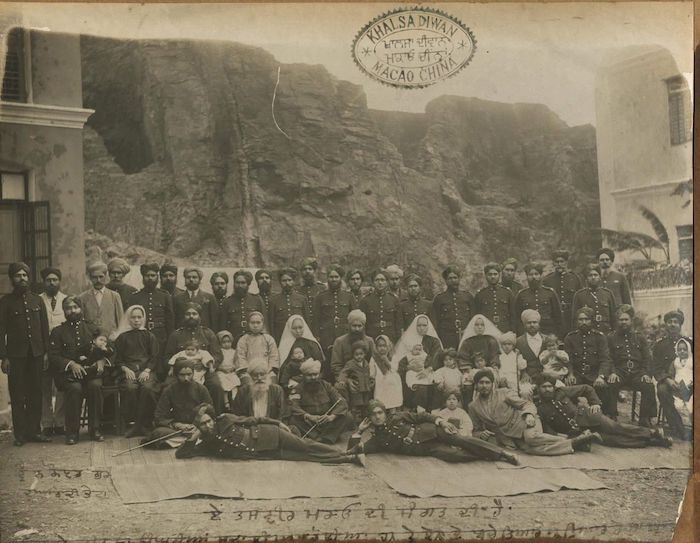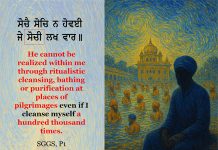
By Gurnam Singh | Opinion |
Sikhs who object interracial marriage should have a close look at this picture of the Sikh Sangat of Macao in Hong Kong with Chinese wives and children. As the stamp shows, the picture is of the Khalsa Diwan Macau, Hong Kong, taken 27th of March 1927. Sikhs came to Hong Kong with the British Army and in 1901, the first Gurdwara (Sikh temple) was built on the site. It was called the Siri Guru Singh Sabah and was constructed by the local Sikh community and Sikh soldiers from the Burma Infantry of the British Army.
Siri Guru Singh Sabah was the name of the organisation that managed the temple, but the name was later changed to the Khalsa Diwan Society. The society was founded in 1902 in the Punjab and it society became an incredible force for unifying the Sikh community around the world. It’s aim was the protection of Sikh identity by institutionalising the Singh Sabha, a movement aimed at re-establishing Sikh values and root out the growing influence of Brahmanical ritualistic practices under British rule.
Another example of Punjabi Sikhs mixing with local populations is in California, specifically with Mexico migrant women, which is documented by Karen Leonard in her 1992 book “Making Ethnic Choices: California’s Punjabi Mexican Americans”. The first marriages between Punjabis men and Mexican women occurred in the early 1900s, soon after Punjabi men started entering the West Coast of the United States via Canada.
The traditional system of arranged marriage for Punjabi Sikh migrants, who were mostly male. became disrupted by strict immigration restrictions. This resulted in the vast majority being forced to turn elsewhere, namely to local Mexican women that worked on their land. These women mostly came across the border to the US after the Mexican Civil War, and they supported themselves by working in the cotton fields of California. Leonard suggests the Punjabi men chose Mexican women because of their physical and cultural similarities with Punjabis, and their willingness to work hard. I suspect it was also because of availability and the needs of the Mexican women as well.
In terms of the Far East, where Sikhs have settled in significant numbers, whilst there appears to be no systematic study on the issue of interracial mixing, anecdotally, in the early days, interracial marriage was not so prevalent. Most Panjabi Sikhs who came over to Malaya and Singapore tended to go back to Panjab for marriage. But in the territory of Sabah and one or two Malayan states, they did marry local women. In the state of Kelantan, for example, they married Siamese women from the state borders of Thailand.
Though, for a variety of factors, patterns of mixing vary across time and space, there are many examples to suggest Sikhs, through design or necessity, have been willing to mix wherever they have settled. However, collectively there still appears to be resistance to accepting this with some Sikhs even hold onto the idea that Sikhs are a distinct ethnic group or even ‘race’, which they feel will the threatened by mixing. Others argue that Sikhs are not a race, caste or even a religion in the traditional sense of the word, but a movement of people. Committed to the revolutionary teachings of Guru Nanak and many other great souls who sought to transcend social divisions and confront all kinds of racist, caste and class-based bigotry, they have no objection to Interracial mixing.
Whilst bigotry can act against human mixing, it seems like such resistance is easily overcome by other factors. Human mixing is a complex phenomenon and can occur in various ways, including through migration, travel, trade, education, and technology. Research suggests that under normal circumstances, people are generally more likely to form relationships with individuals who are similar to them in terms of race, ethnicity, creed and culture. However, there has been a growing trend of interracial relationships in many societies, which can be attributed to many factors, such as increased exposure to people from different backgrounds, and changing social attitudes towards race and interracial relationships.
Sikhs are no different to other communities in that attitudes towards interracial marriage can vary among individuals and families, with some Sikh families being more accepting than others. Indeed, there is evidence that some maintain very rigid feudal views and associate marriage put of race, religion or caste as being dishonourable. Couched in terms of a narrative of ‘izat’ or honour, in extreme cases, this can result in what has become known as ‘honour crimes’. These are acts of extreme violence, often resulting in the murder of a woman or girl by male family members by claiming that they have brought dishonour upon the family name or prestige.
Though such crimes take place in Punjabi communities, there is no place for honour crimes or any kind of violence against women and girls in Sikh. Indeed, Sikh values simply do not allow us to make distinctions of race, caste, class and gender and once we begin to water down these commitments we cease to deserve to call ourselves Sikhs. Because of the dominant culture in the various places where Sikhs live the world, maintaining these commitments is not easy, but one does not become a Sikh because one wants an easy life.
To adopt the oath of the warrior who dedicates their life to fighting oppression is a perilous path; this is why our history is littered with so many sacrifices. As the17th Century Sikh scholar, Bhai Gurdas Ji states in one of his compositions:
ਗੁਰਸਿਖੀ ਬਾਰੀਕ ਹੈ ਖੰਡੇ ਧਾਰ ਗਲੀ ਅਤਿ ਭੀੜੀ।
The oath of a Gursikh is very subtle like a sword edge and narrow alley.
ਓਥੈ ਟਿਕੈ ਨ ਭੁਣਹਣਾ ਚਲਿ ਨ ਸਕੈ ਉਪਰਿ ਕੀੜੀ।
On this path even mosquitos and ants cannot stand there.
ਵਾਲਹੁ ਨਿਕੀ ਆਖੀਐ ਤੇਲੁ ਤਿਲਹੁ ਲੈ ਕੋਲ ਪੀੜੀ।
It is thinner than hair and finer than the oil of sesame obtained after crushing it in the crusher.
ਗੁਰਮੁਖਿ ਵੰਸੀ ਪਰਮ ਹੰਸ ਖੀਰ ਨੀਰ ਨਿਰਨਉ ਚੁੰਜਿ ਵੀੜੀ।
The Guru-centred ones have the discerning abilities of swans that can separate water from milk with their beak of thoughtfulness.
ਸਿਲਾ ਅਲੂਣੀ ਚਟਣੀ ਮਾਣਕ ਮੋਤੀ ਚੋਗ ਨਿਵੀੜੀ।
Like licking the salt-less stone they pick up the rubies and jewels to eat.
ਗੁਰਮੁਖਿ ਮਾਰਗਿ ਚਲਣਾ ਆਸ ਨਿਰਾਸੀ ਝੀੜ ਉਝੀੜੀ।
The Guru-centred ones, repudiating all hopes and desires, move on the way of detachment and tear down the veil of Maya.
Though Sikhs originate from the Punjab, today Sikhs are rapidly becoming a global people. The mixing of human beings according to evolutionary theory is not a choice but a biological necessity for the survival of humanity. Indeed, contrary to popular racial myths, there is more genetic variation within ethnically and culturally defined groups than between groups. Human diversity is the natural order of things and nothing can stop human beings from mixing. Hence fighting diversity is futile, and the task is to find ways to embrace it to enhance and expand our horizons. And because Sikh values are eternal, there is no reason to fear these may be lost in the process of mixing.

Gurnam Singh is an academic activist dedicated to human rights, liberty, equality, social and environmental justice. He is an Associate Professor of Sociology at University of Warwick, UK. He can be contacted at Gurnam.singh.1@warwick.ac.uk
* This is the opinion of the writer and does not necessarily represent the views of Asia Samachar.
RELATED STORY:
Miracles and Godmen (Asia Samachar, 31 July 2020)
ASIA SAMACHAR is an online newspaper for Sikhs / Punjabis in Southeast Asia and beyond. When you leave a comment at the bottom of this article, it takes time to appear as it is moderated by human being. Unless it is offensive or libelous, it should appear. You can also comment at Facebook, Twitter, and Instagram. You can reach us via WhatsApp +6017-335-1399 or email: asia.samachar@gmail.com. For obituary announcements, click here.


































What a brilliant and liberating article. No religion or faith should be above humankind. It is sad to hear and witness that many Gurdwaras in Malaysia are not willing to let interracial marriages take place without the person from another faith first accepting Sikhism. This is not the way of our Guru’s.
“And because Sikh values are eternal, there is no reason to fear these may be lost in the process of mixing.”
Comments are closed.